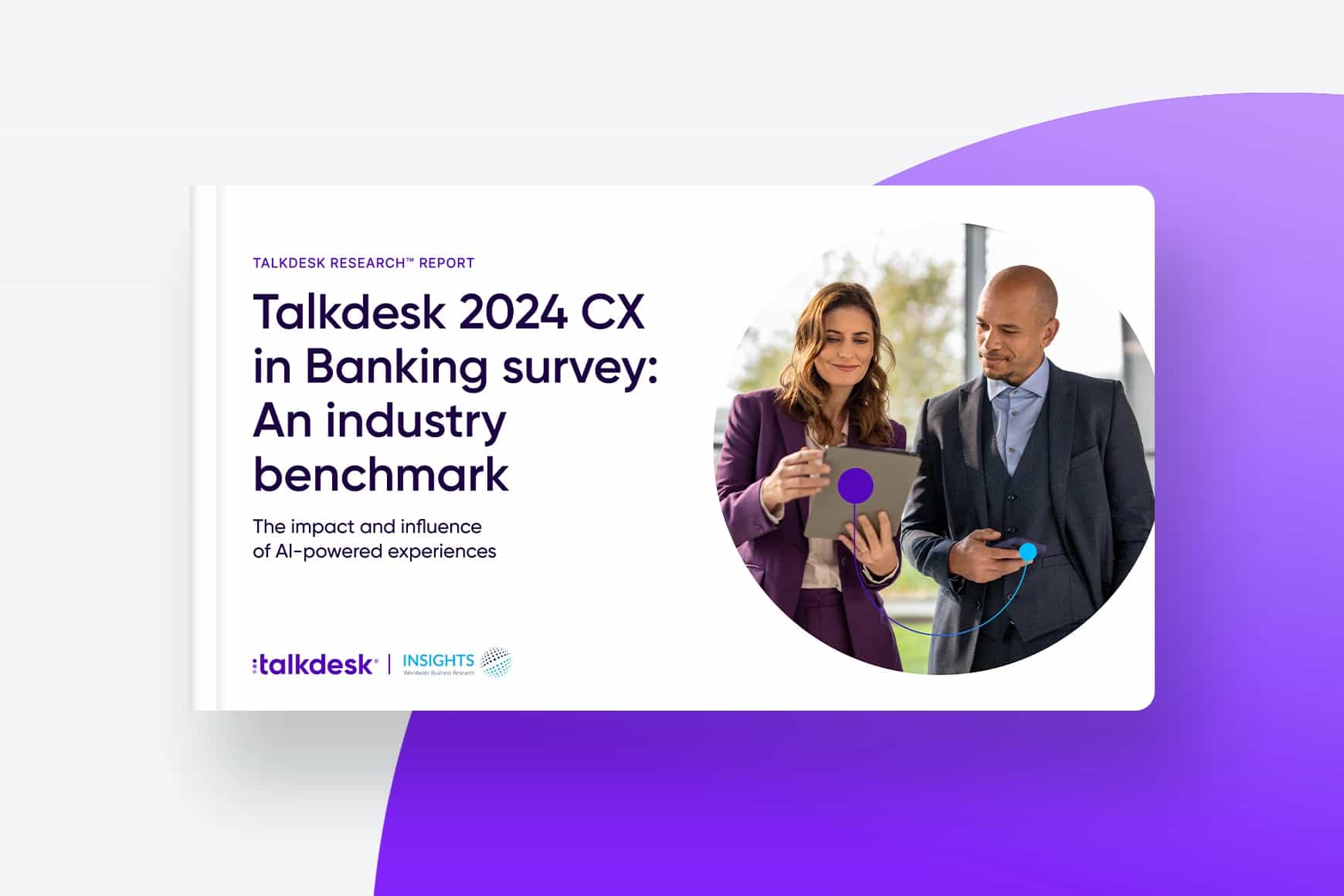The future of omnichannel banking: 91% expect integrated channels within three years

By Taylor Grace
0 min read

Omnichannel customer service has revolutionized the banking landscape and completely changed how customers interact with financial institutions. The integration of multiple channels like mobile apps, websites, and in-person services has elevated the customer experience, offering convenience and accessibility. Omnichannel banking solutions have empowered customers with a cohesive, interconnected banking journey blurring the lines between physical and digital banking.
The Talkdesk 2024 CX in Banking survey: An industry benchmark reports this change, highlighting its critical role for customer experience (CX). Nearly all respondents (97.5%) agree on the growing importance of CX in banking.

Report
Talkdesk 2024 CX in banking survey: An industry benchmark
Find out the impact of AI-powered CX technology on banking customer service operations, including the drivers, benefits, and barriers to implementing an omnichannel strategy that combines agent-led support with AI-driven self-service options.
The importance of customer experience (CX) in banking.
The survey results affirm the industry’s shift from transaction-based to experience-driven relationships. A notable 82.5% of respondents view CX as vital for customer loyalty and retention. This focus on CX aligns perfectly with the evolving demands of modern customers seeking a banking experience that is not only efficient and reliable but also personalized and responsive. This shift in customer expectations is driving banks to reconsider and redesign their customer interaction strategies.
The survey findings also highlight that customers now expect a banking experience that integrates seamlessly into their daily lives, providing convenience and ease at every touchpoint. Whether it’s through digital platforms like mobile banking apps or traditional in-branch interactions, customers desire a consistent, cohesive, and personalized experience.
Furthermore, the survey indicates that this shift towards prioritizing CX is not just a trend, but a fundamental change in how banks operate and engage with their customers. By focusing on CX, banks are not only meeting current demands but also preparing to quickly adapt to future changes in customer preferences and technological advancements.
Investing in and improving CX allows banks to significantly enhance customer satisfaction and loyalty, driving growth and retention. A successful CX strategy is invaluable for banks to gain competitive advantage in a market where products and services are often similar.
The core of customer frustration: Disjointed channel experiences.
The Talkdesk 2024 CX in Banking survey: An industry benchmark unveils a crucial aspect of customer dissatisfaction in the banking sector—frustration stemming from a lack of channel integration. This issue surpasses even the absence of channel options in its impact on customer experience. A significant 80% of survey respondents identified disjointed experiences while moving across various communication channels as a leading cause of customer frustration.
The ripple effects of inefficiencies: Repeating information and accessibility issues.
Moreover, the survey highlights two other major pain points contributing to customer frustration. Firstly, the need to repeatedly provide the same information, as cited by 68.5% of respondents, indicates a gap in information flow and retention across channels. Secondly, 63.5% of respondents point to difficulties in accessing information or support as a significant frustration. This issue could stem from inefficient channel design, lack of intuitive interfaces, or inadequate integration of customer service resources across platforms. Both these factors influence the overall perception of a bank’s efficiency and customer-centricity, directly impacting customer loyalty and satisfaction.
The need for integrated channel strategies.
The insights from the survey emphasize the importance of integrated channel strategies in banking. Banks must prioritize creating a cohesive customer journey, where each touchpoint—whether digital or physical—is aligned, and information is seamlessly shared across platforms. This approach addresses the immediate frustrations highlighted by customers and lays a foundation for a more responsive and agile banking experience that can adapt to evolving customer needs and technological advancements.
Resolving customer frustration through channel optimization.
The significance of channel optimization can’t be understated. The survey reveals a comprehensive picture of how banks are currently engaging with their clients. All respondents (100%) indicated that their bank or credit union utilizes traditional channels like email, phone, and SMS/text for customer interactions. Additionally, a substantial majority reported using digital channels, such as live chat via an application, 97.5%, and on their websites—96.5%. These figures not only highlight the diverse array of channels in use but also reflect a keen understanding within the banking sector of the need to meet customers where they are—be it traditional or digital platforms.
Looking ahead, the survey indicates a strategic shift towards integrating more advanced technology-driven channels over the next three years. This shift aligns with expected investments in AI and self-service, spotlighting an industry on the cusp of a digital revolution.
Innovations on the road towards omnichannel banking in the next three years:
- Voice-based virtual agents. Banks are preparing to introduce voice-based virtual agents, with 69% of respondents indicating their adoption. This technology offers a more intuitive and natural way for customers to interact with their banks, using voice commands and natural language processing.
- Chatbots on websites. A significant 63% of banks plan to adopt chatbots on their websites. These chatbots are designed to provide instant, automated responses to customer inquiries, enhancing customer service efficiency and offering quick solutions to common queries.
- Chatbots in applications. Close behind website chatbots, 62% of banks are focusing on integrating chatbots within their mobile and desktop applications. This move aims to streamline customer interactions within the app, providing a seamless experience from inquiry to resolution.
- Video chat. Nearly half of the respondents, at 48%, plan to incorporate video chat capabilities. This addition reflects a trend towards more interactive and personalized customer engagement methods, allowing for face-to-face conversations in a digital format.
By integrating these innovative methods, banks are set to offer a more cohesive, efficient, and personalized customer experience.
Challenges in achieving channel integration.
The road to fully integrated omnichannel banking does come with challenges. Banks and credit unions alike have reported that the most common challenges revolve around:
- Resistance to change. One of the most significant barriers to integration is the inherent resistance within organizations to overhaul existing systems.
- Technological constraints. The lack of advanced technological infrastructure can impede the path to integration
- Skill gaps. The shortage of skilled professionals to navigate and implement complex integration strategies remains a concern.
Looking ahead: Embracing full integration across engagement channels.
The survey found that within the next three years, an overwhelming majority of respondents—91%—expect their organizations to be either fully or mostly integrated across engagement channels. This is a considerable leap from the current state of affairs, indicating a strong commitment across the sector to enhance omnichannel customer service.
Current state of channel integration:
- Limited integration: 11.5% is still at the early stages of channel integration, indicating an early stage approach to omnichannel banking.
- Some integration: 49%, the largest proportion of banks, currently falls under this category, showcasing a partial, yet growing commitment to omnichannel strategies.
- Fully integrated: 0.5%of institutions have achieved full integration, representing the leading edge of digital transformation in banking.
- Mostly integrated: 39% is nearing the completion of their omnichannel integration, leading the way in this digital shift.
Projected channel integration in three years:
- Some integration—3.5%: Expected to decrease significantly as more banks advance their integration strategies.
- Limited integration—5%: A small fraction will still be in the initial stages of integration.
- Fully integrated—27.5%: A substantial increase, indicating a significant stride towards complete omnichannel integration.
- Mostly integrated—63.5%: The majority of banks are anticipated to be on the verge of full integration.
Another compelling insight on this topic is the clear correlation between channel integration and key business outcomes, particularly customer loyalty and deposit retention. Financial institutions that have achieved significant levels of integration are four times more likely to strongly believe in the impact of customer experience as a leading driver of customer loyalty and deposit retention. This correlation underscores the strategic importance of omnichannel integration, not just as a technological upgrade, but as a vital component in fostering strong customer relationships and securing financial stability.
Final thoughts.
The future of omnichannel banking is marked by a shift towards comprehensive channel integration, bridging the current gaps and setting the stage for a banking experience that is both seamless and customer-centric. As banks and credit unions continue on this path, they are not only enhancing their operational efficiencies but are also significantly boosting their capabilities in fostering customer loyalty and securing long-term financial stability.
For a deeper dive into these trends and to understand how your organization can navigate this changing landscape, access the full survey here. Discover the strategies, challenges, and expectations shaping the future of banking in an AI-driven world.






